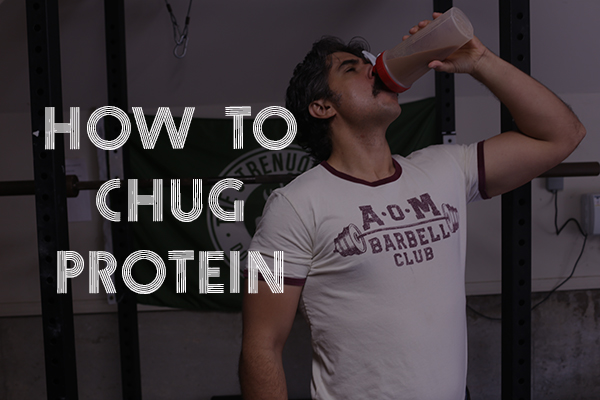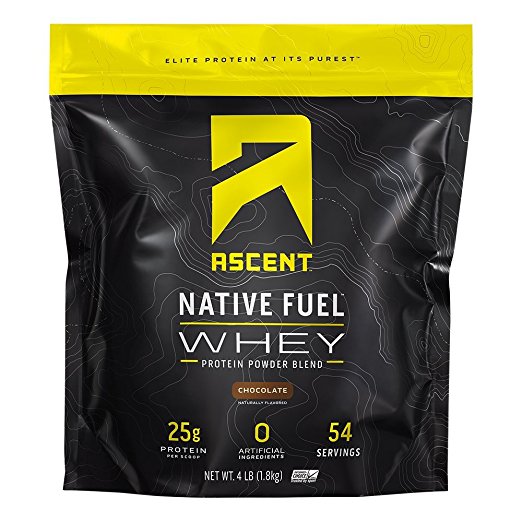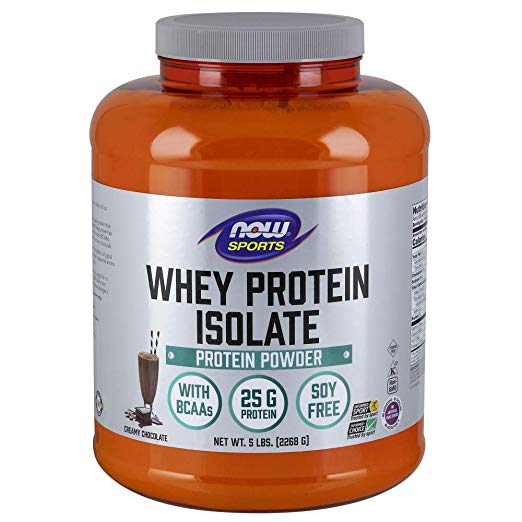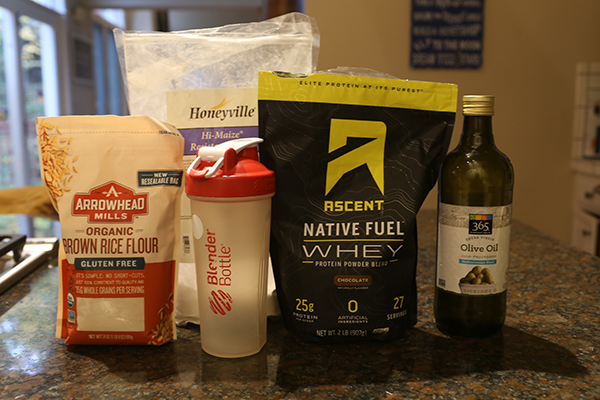If you’re serious about working out and weight training, you need to be serious about your protein consumption. Protein provides the amino acids your muscles need to rebuild and get stronger after a training session. It also helps you feel satiated, which is useful when you’re trying to lose weight.
As a general guideline, active folks should aim to get .5 to .8 grams of protein per pound of body weight each day. If you’re doing really intense barbell training, shoot for .8 to 1 gram of protein per pound of body weight.
Now it’s possible to get all the protein you need from eating whole foods like eggs, chicken, fish, meat, and even some vegetables, but it can require eating a lot of food, which means you’ll need to spend a lot of time preparing that food or paying a lot of money for someone else to prepare it for you.
A supplement in the form of whey protein can help you hit your protein goals cheaply and with almost no hassle. Just a little decision making and commitment.
Below I share how I chug my protein. Perhaps it will give you some ideas on how to chug yours.
Which Type of Protein Supplement Should You Use?
There are different types of protein powders on the market to choose from that have different benefits and costs: casein, soy protein, egg albumin, etc. Unless you have some sort of digestive intolerance or dietary restriction, you’ll get the best bang for the buck by using a supplement made from whey, which comes from milk and is a byproduct of the cheese/yogurt-making process.
Whey protein has a higher biological value (the quality of the protein based on how efficiently the body utilizes it, which correlates with having a high supply of essential amino acids) than any other protein source, including beef, eggs, beans, soy, and casein.
Whey comes in the form of both concentrate and isolate, and you want a protein supplement that is primarily composed of the latter. Whey isolate contains a higher percentage of pure protein than whey concentrate, and is processed to contain less lactose, carbohydrate, fat, and cholesterol. Isolate can also be easier on the stomach than whey concentrate.
While a bit more expensive than whey concentrate, whey isolate is still relatively cheap.
So for the most part, stick with a supplement that’s primarily made with whey protein isolate (make sure it’s listed as the first ingredient on the label).
What Brand of Whey Protein Should You Use?
So you should use a protein supplement that’s primarily whey protein isolate, but which particular brand should you get?
My recommendation is to find the “cleanest” supplement that fits your budget. The kind of protein that you grab off the shelf at Walmart is affordable, but contains fillers, additives, and artificial flavors, colors, and sweeteners. While I’m not a purist about no-artificial-anything in my diet, when it comes to whey protein, which you may be consuming several servings of every day, you don’t want to be slamming back junk.
That being said, your choice ultimately comes down to personal preference and what’s important to you. There are tons of whey protein isolate products out on the market with different tastes, textures, nutritional profiles, and price points.
Here are 3 of my recommendations in 3 different categories of preference:
Cleanest/Best Taste
In pursuit of a clean whey protein isolate, I used the Jay Robb brand for awhile, which is made without anything artificial and gets its whey from the milk of grass-fed cows. But it wasn’t my favorite: it had too much stevia-based sweetness for my taste and it’s really expensive — about $1.80 per serving.
I recently switched to the Ascent brand, and it may be my favorite whey protein supplement yet. Here’s why I like it:
- Tastes great — I’ve tried the Chocolate and the Lemon Sorbet and liked both
- No artificial colors, flavors, sweeteners (sweetened with monk fruit and stevia)
- Isn’t very thick — with some brands you’ve got to mix the powder with 8 ounces of water to cut the thickness and the sweetness; with Ascent, you can use just 4 ounces and it’s still not sludgy or cloying
- They make their own whey — most whey protein companies out there actually all source their whey from the same handful of big manufacturers, and then doctor it up with their own blend of colors/flavors; Ascent makes their protein in their own factory
- They claim their whey is “the least processed protein available today because it’s filtered directly from high-quality milk” instead of being a byproduct of the cheese-making process
- It’s unbleached (some companies bleach their whey protein to remove its naturally yellowish color)
Though it’s not sourced from grass-fed cows, you’ll still pay a premium for the overall cleanness of this protein powder; nonetheless, its price — $1.20 a serving (for the 4-lb size) — is decent for a top quality supplement.
Cleanest/Best Price
If Ascent is outside your budget, but you’re still wanting a clean whey protein, check out Now Sports Whey Protein Isolate. It’s pure whey isolate (no concentrate), doesn’t have artificial flavors or sweeteners (sweetened with xylitol and stevia), and clocks in at a bargain basement $.80 a serving. The taste isn’t that great, but that may be an acceptable trade off for the price/nutritional profile.
You can actually go even cheaper by getting Now Sports’ unflavored whey protein isolate: it has only 2 ingredients — whey protein isolate and sunflower lecithin — and it’s just $.70 a serving. Naturally the taste is not so hot, but some people find it tolerable, even on its own, and you can also add cinnamon or vanilla extract to it, or just mix it in a smoothie or with a flavored base.
Best Price/Best Taste
If affordability and taste are higher priorities for you than cleanness, then I recommend COR-Performance Whey Protein. You can buy big 5-lb jugs of it which last a long time and drive down the cost per serving to just $.64! COR-Performance does contain fillers, artificial flavors, and not just one but two artificial sweeteners, but as a trade-off (or really, as a natural consequence!), it’s probably the best-tasting whey protein on the market and it comes in flavors beyond your typical vanilla or chocolate. I used COR-Performance in the past and my favorites were Peanut Butter Marshmallow and Cinnamon Swirl.
Experiment with different whey proteins (remembering to make sure that whey isolate is the first ingredient listed on the label), and see which best fits your personal matrix of budget, nutrition, and taste. And, honestly, don’t neglect the latter: if you hate the taste of something, compliance in drinking it is going to be hard to achieve.
How I Drink My Whey Protein
For me, whey protein is about convenience and speed. I don’t use any fancy protein shake recipes that involve blending in bananas, kale, peanut butter, and berries. And then cleaning and re-cleaning a blender a few times a day. Ain’t nobody got time for that.
I just use water as the liquid base for my protein shakes. That’s it. No milk. The Ascent protein tastes great with just water. And I mix it in a standard mixer bottle with shaker ball; I have several of them so I don’t have to wash a lone shaker between servings and can just throw them all in the dishwasher at the end of the day.
While I don’t make fancy smoothies with my whey protein, I do make quasi-meal replacement shakes with it. I follow an “If It Fits Your Macros” plan, so I need to hit a certain amount of carbs, protein, and fat each day. My shakes serve as a supplement in hitting those macros.
I consume two of these shakes a day — between breakfast and lunch, and between lunch and dinner.
To make them, I fill a shaker bottle half way up with water and toss in two scoops of Ascent whey for my protein.
For my carbs, I’ll either add in ½ cup of brown rice flour or oatmeal flour. Or if I need to get some more fiber in my diet, I’ll do ¼ cup of brown rice flour and ¼ cup of hi-maize resistant starch (Which has 18 grams of fiber in ¼ a cup. Your colon will thank you. Or hate you.).
For my fats, I’ll just toss in a tablespoon or two of olive oil, depending on my fat goals for the day.
If I’m taking my shake post-workout, I’ll throw in a scoop of creatine.
Shake everything up and chug it.
Does it taste gross? Not really. But I have the palette of garbage-eating raccoon, so I might not be the best person to ask about the palatability of something. It gets the job done, and that’s all I care about. For me, my body is a machine, and a shake is just fuel. I’m looking for function, not a delectable delight.
If I’m ever at the end of the day, and I’ve fulfilled my carb and fat macros but am short by 25 grams or so of protein, I’ll have a shake with just water and a scoop of whey. Boom. Macros accomplished.
For When You’re Feeling Frisky: Diet Soda + Whey Protein
If you’re looking to mix up your whey protein consumption and want to try something different, but still don’t want to bust out your blender, try using a diet soda as the liquid base — a tip I learned from my Barbell Logic Online Coaching coach, Matt Reynolds.
If you’re not into artificial sweeteners, you can make these concoctions with Zevia-brand sodas, though if you’ve tried that kind of soda, you know it’s passable, but certainly not as tasty as the “mainstream” variety.
A few good combos:
- Vanilla whey protein + diet root beer = Root beer float
- Vanilla whey protein + diet orange soda = Dreamsicle
- Vanilla whey protein + Diet Sprite = Sort of like a key lime pie
- Chocolate whey protein + diet root beer = Hard to describe. Tastes good, though!
- COR-Performance Cinnamon Swirl + Diet Coke = Haven’t tried this one, but Reynolds recommends this “recipe”
Be careful opening up the shaker top after shaking things up with diet soda. You’ll have a lot of built-up gas, and if you just abruptly remove the top, you’ll have a little mini explosion. Open slowly.
Happy chugging!













